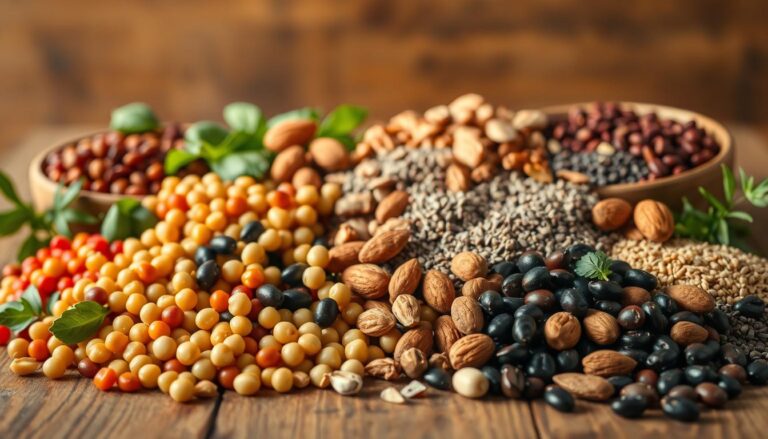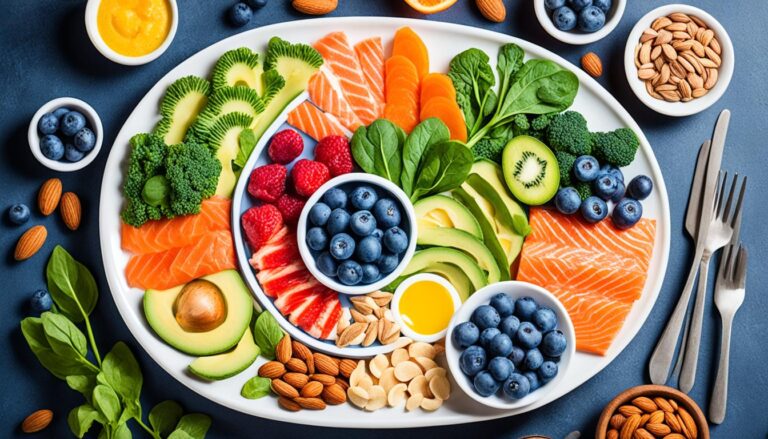Healthy Eating for Weight Loss many people expect progress to show up only as numbers on a scale. Yet clinical research and reviews show that shifting to plant forward minimally processed patterns can lower blood pressure improve cholesterol and glucose control and boost daily energy without rapid body changes.
This guide reframes success it focuses on measurable health gains and better mood, not just losing weight fast.
We’ll preview practical versions of Mediterranean DASH, plant based and flexitarian plans the MIND approach for cognition, and intermittent fasting.
Each pattern targets distinct outcomes, yet they share common threads: fiber rich carbs, unsaturated fats less sodium and added sugar, and more whole foods.
Small repeatable swaps like adding leafy greens or switching to whole grains can compound into real cardiometabolic improvements before any visible body change.
Key Takeaways
- Focus on clinical markers: blood pressure, lipids, and glucose can improve even with stable body mass.
- Plant-forward and Mediterranean-style patterns appear often in studies as effective for long-term health.
- Consistent, realistic habits beat rapid diet fixes for lasting gains.
- Small swaps at the grocery store and home cooking add up over time.
- Choose a pattern that fits culture, budget, and daily routines for better adherence.
Why Healthy Eating Matters Even When the Scale Doesn’t Move
Dietary shifts toward whole foods and unsaturated fats can lower cardiometabolic risk even if the number on the scale holds steady.
Nutrient-dense patterns such as Mediterranean and DASH improve vascular function, raise HDL and improve triglycerides, and help steady glucose control. These changes show up on lab work and in daily energy before clothing sizes change.
High-fiber carbs, antioxidants, and unsaturated fats support endothelial health and cut oxidative stress. That helps reduce inflammation markers early in the process.
Practical gains matter: better blood sugar control reduces afternoon slumps and curbs cravings, so many people naturally moderate calories without strict rules.
- Minor shifts in dietary pattern improve lipid and glucose profiles.
- Portion awareness and smart choices about dairy products and fats beat demonizing single foods.
- Consistency shopping lists, prep, label reading builds results over weeks and months.
Measure progress with labs, blood pressure, and how you feel, not only the scale.
Reviews of multiple diets consistently report heart protection and cognitive support from quality patterns. Sustainable routines, not rapid fixes, deliver lasting health improvements.
Understanding Health Benefits Beyond Weight Loss
Improving daily food choices often shows measurable health wins in weeks, not months. Clinical trials of Mediterranean and DASH style diets report faster changes in cardiometabolic markers than in body mass. These effects come from higher plant intake, whole grains, and more unsaturated fats, independent of body composition shifts.
Risk factors that improve without losing weight
Key markers that commonly respond first include systolic and diastolic pressure LDL cholesterol, triglycerides hs-CRP, and fasting glucose or insulin.
- Blood pressure: more potassium-rich foods and less sodium support pressure control quickly.
- Lipids: unsaturated fats from olive oil nuts, and fish lower LDL and improve triglycerides.
- Inflammation glucose: fiber and polyphenols reduce hs-CRP and help steady fasting glucose.
From pressure to inflammation what changes first
Fiber and polyphenols improve lipid metabolism and endothelial function by slowing absorption and lowering oxidative stress. That helps arteries relax and improves circulation.
Potassium-packed fruits and vegetables blunt sodium’s effect on the vasculature, so pressure readings can fall even when weight stays stable.
Better glycemic control reduces post-meal fatigue, stabilizing energy and mood across the day. Many people notice these shifts in weeks as metabolism adapts.
Cardiometabolic markers often change faster than body composition in both observational and interventional studies.
Track progress with home pressure readings and regular labs. Small, consistent dietary choices more plants, whole grains, and unsaturated fats compound into meaningful risk reduction for people who keep their weight steady.
How Dietary Patterns Support Heart Health and Blood Pressure
How we eat shapes blood flow, inflammation, and cholesterol in ways that matter for heart health.
Lowering pressure with nutrient rich foods
Potassium, magnesium, calcium, and fiber from vegetables, fruits, beans, and whole grains help regulate vascular tone and lower blood pressure quickly.
Fiber slows glucose spikes. Minerals support smooth muscle function in arteries. Together they ease arterial stiffness that drives high readings.
Reduce added sugars and refined grains to blunt triglyceride surges after meals and steady daily energy.
Protecting against heart disease and stroke
Replace saturated fat with olive oil, nuts, and fatty fish to improve lipid profiles linked to lower heart disease and stroke risk.
Limit sodium to help fluid balance and reduce pressure, especially for people with hypertension. The DASH pattern and Mediterranean-style diets both show benefits in trials and reviews, often before measurable weight change occurs.
Small swaps whole-grain bread, an olive oil dressing, a handful of nuts—compound into meaningful cardiovascular risk reduction.
- Add leafy greens and swap refined grains for whole grains.
- Season with herbs and citrus instead of salt.
- Monitor pressure at home and keep consistent meal timing.
The DASH Diet Dietary Approaches to Stop Hypertension
This approach prescribes specific per-day servings to help people manage blood pressure and metabolic risk.

How DASH works: servings per day and sodium limits
The DASH diet sets clear targets to simplify shopping and meal prep. Aim for roughly five servings of vegetables and five of fruit, about seven servings of healthy carbs like whole grains, and two servings of low-fat dairy products each day.
Limit lean meats to two or fewer servings, and include nuts or seeds two to three times weekly. Keep sodium low by choosing fresh or low-sodium packaged items and by seasoning with herbs, citrus, and spices.
| Food group | Servings per day | Practical swap |
|---|---|---|
| Vegetables | 5 | Roast mixed veggies instead of fries |
| Fruits | 5 | Fresh fruit or plain fruit with yogurt |
| Whole grains | 7 healthy carbs | Oats, brown rice, whole wheat bread |
| Low-fat dairy | 2 | Skim milk or low-fat yogurt |
| Lean protein nuts | 2 or nuts 2–3/wk | Skinless poultry, beans, handful of nuts |
Effects on blood pressure metabolic health and mood
Randomized trials and reviews show the dash diet lowers systolic and diastolic values within weeks. It also improves lipids and insulin sensitivity.
People often report steadier energy and better mood with consistent fiber and balanced meals. Some studies link adherence to fewer depressive symptoms over time.
DASH reduces blood pressure and improves several cardiometabolic markers in short-term trials.
Who benefits most from a low-sodium plan
Individuals with hypertension or medical needs for sodium restriction gain the most from aggressive limits. Others can personalize sodium to taste and health goals.
Sample day: oatmeal with fruit and low-fat yogurt at breakfast salad and whole-grain bread at lunch vegetable-centered dinner with lean protein snacks of fruit or a small handful of nuts. This pattern raises fiber lowers calorie density, and can support modest weight loss without strict counting.
Practical tips: read labels for sodium and added sugars phase in low-sodium swaps, and adapt recipes to local cuisines and budgets.
The Mediterranean Way of Eating for Longevity and Disease Prevention
The Mediterranean pattern centers on simple pantry staples and seasonal produce that support long-term longevity.
Core pantry and why it matters
Stock extra-virgin olive oil, nuts and seeds, whole grains, legumes, and plenty of vegetables and fruits. Include regular fish, lentils, and modest amounts of poultry, eggs, and dairy.
How fats and protein protect the heart
Olive oil and nuts supply monounsaturated and polyunsaturated fats that support favorable lipids and lower risk of heart disease. Plant proteins and fish add omega-3s and satiety.
Evidence and practical swaps
Observational studies and randomized trials link this diet to lower all cause mortality and reduced cancer risk in some groups. High satiety foods and less reliance on processed foods help many people maintain or steady their weight over time.
- Swap olive oil for butter.
- Use beans to replace some red meat portions.
- Choose whole-grain pasta instead of refined varieties.
A Mediterranean-style pattern combines nutrient density and simple preparations to lower chronic disease risk.
Practical notes: limit processed meats and added sugar, eat oily fish regularly for omega-3s, and moderate dairy while ensuring calcium and vitamin D through food or supplements as needed.
Plant Based and Flexitarian Eating Patterns
Approaches that center plants but allow some animal foods aim to balance nutrition and practicality.
Flexible approaches and definitions
Vegetarian limits meat and fish but may include dairy and eggs. Vegan excludes all animal products. Flexitarian prioritizes plants while permitting occasional meat or fish.
Metabolic markers and evidence
Reviews and at least one major cohort study link plant-forward diets with lower type 2 diabetes risk and reduced blood pressure. These patterns also tend to lower LDL cholesterol and improve metabolic health in many people.
Protein planning matters. Use legumes, tofu, tempeh, quinoa, nuts, and seeds to meet protein needs with less saturated fat. Fortified foods or supplements help with B12, and attention to iron, calcium, and omega-3s is prudent on stricter plans.
Higher fiber and lower calorie density often raise satiety and improve markers before major body changes occur.
- Start with meatless days and bean-based dinners.
- Keep dried beans, lentils, oats, and brown rice on hand to reduce cost.
- Monitor blood pressure and glucose to see early improvements.
| Pattern | Animal food rule | Key staples |
|---|---|---|
| Vegetarian | No meat/fish may include dairy eggs | Legumes, dairy, eggs, whole grains |
| Vegan | No animal products | Tofu, tempeh, fortified plant milk, seeds |
| Flexitarian | Mostly plant occasional meat or fish | Beans, oats, nuts, seasonal vegetables |
The MIND Diet for Brain Health
The MIND pattern merges DASH and Mediterranean ideas to prioritize foods that support memory and brain resilience. It sets simple weekly targets so people can plan meals without extra complexity.
Key food groups and weekly targets
The MIND plan encourages six or more servings of leafy greens weekly and one serving of other non-starchy vegetables daily.
It also recommends five or more servings of nuts per week, regular berries, beans, whole grains, olive oil, fish twice weekly, and modest poultry. Limit butter, cheese, red meat, fried foods, and sweets.
Cognition Alzheimer’s risk and healthy aging
Polyphenols and antioxidants in berries and greens may protect neurons and lower oxidative stress. These compounds support cognitive resilience and slow decline.
Higher MIND adherence associates with reduced Alzheimer’s risk and slower cognitive decline in several cohort studies and reviews.
- Why limits matter: cutting butter, cheese, fried foods, sweets, and red meat may reduce neuroinflammation and vascular risk.
- Practical tips: batch-cook beans, keep frozen berries on hand, and place extra-virgin olive oil where you will use it daily.
- Aim for fish twice a week and flexible poultry servings to balance protein and cost.
- Moderate adherence still shows gains adopt changes stepwise and adapt recipes to cultural tastes.
Pair the MIND plan with regular activity and sleep hygiene. Track brain-healthy habits alongside routine cardiometabolic checks for a whole-health view.
Intermittent Fasting Timing Your Meals for Health Gains
Meal timing strategies like daily time-restricted eating change fuel use and can support cardiometabolic goals. Intermittent fasting alternates fasting and eating windows rather than prescribing specific foods.
Popular methods:
- 16/8 eat during an 8-hour window each day and fast for 16 hours.
- 5:2 eat normally five days and limit to 500–600 calories on two nonconsecutive days.

How metabolic switching helps
After extended fasting, the body uses stored glycogen then shifts toward fat oxidation. This metabolic switching can improve insulin sensitivity and support fat reduction while preserving lean mass in some studies.
Practical guidance and safety
- During fasts drink water, black coffee, or unsweetened tea only.
- Make eating windows count: choose nutrient-dense, Mediterranean-style meals with enough protein and fiber.
- Start gradually: shorten the eating window over two to four weeks to adapt.
Research and reviews link intermittent patterns to better blood pressure, lower resting heart rate, reduced inflammation, and improved glucose markers in some people.
Monitor energy, sleep, and concentration adjust the plan if signs of fatigue or low mood arise.
Who should avoid fasting: children, teens, pregnant or breastfeeding people, those with type 1 diabetes on insulin, or anyone with a history of eating disorders. Consult a clinician before starting if you have chronic conditions or obesity-related comorbidities.
Healthy Eating Delivers Benefits Even Without Weight Loss
Small shifts in daily food choices can show up quickly on labs and blood pressure monitors.
Blood pressure, cholesterol, and glucose improvements
Cardiometabolic markers including systolic and diastolic pressure, LDL cholesterol, triglycerides, fasting glucose and insulin often improve within weeks of a better diet.
Fiber and unsaturated fats slow glucose peaks and help lower LDL without major changes in body shape. Trials of Mediterranean and the dash diet, and some intermittent fasting work, report faster gains in these labs than in weight.
| Marker | Typical early change | Why it improves |
|---|---|---|
| Blood pressure | ↓ within weeks | More potassium, less sodium, better vascular tone |
| LDL triglycerides | Moderate ↓ | Higher unsaturated fats and fiber |
| Fasting glucose/insulin | Improved stability | Slower absorption, lower spikes |
Energy, mood, and quality of life enhancements
Many people report steadier energy, fewer afternoon crashes, better sleep, and clearer focus after changing dietary habits.
These real-world gains less brain fog, fewer headaches, improved daily performance pair with lab wins and reduce long-term risk when sustained.
Tip: Track home pressure readings and periodic labs, choose culturally familiar meals, and add light activity to amplify results without counting every calorie.
Food Groups to Prioritize Each Day
Prioritizing core food groups each day makes meal planning simpler and lab results more predictable. Aim for a pattern that fills half the plate with produce and balances the rest with whole grains and lean protein.
Vegetables and fruits: fill half your plate
Make vegetables and fruits the largest portion of each meal. This boosts fiber, potassium, and antioxidants that lower cardiometabolic risk. Follow U.S. guidance and choose variety across colors.
Whole grains, beans, nuts, and seeds
Include whole grains such as oats, brown rice, and whole-grain pasta to support cholesterol and digestive health. Add beans and legumes for minerals and fiber rinse canned beans to cut sodium.
Fish, skinless poultry, and plant proteins
Choose fish twice per week, favoring oily varieties for omega-3s. Rotate skinless poultry and lean cuts with plant proteins like tofu, lentils, and quinoa to lower saturated fat intake.
- Build plates: half produce, one-quarter whole grains/legumes, one-quarter protein.
- Have a small daily serving of nuts or seeds for heart-healthy fats and extra protein.
- Watch portions and hydrate to manage calories and steady energy these choices support reduced diabetes risk long term.
Simple daily patterns beat rare strict diets consistency drives results.
Foods and Ingredients to Limit for Better Outcomes
Some common ingredients track with higher cardiometabolic risk and deserve careful limits.
Processed foods, added sugars, and refined grains are major drivers of calorie surges and triglyceride spikes. Cut sugary beverages and refined snacks to lower quick glucose swings and extra calories.
What to watch in your pantry and fridge
Limit high-sodium items and salty sauces to help lower pressure. Choose low-sodium products when possible, and drain and rinse canned goods to remove excess salt.
Reduce saturated fat by favoring lean proteins and plant oils. Avoid trans fat and partially hydrogenated oils entirely. Swap tropical oils like coconut and palm for olive or canola.
Choices that lower long-term risk
Cut back on fatty or processed red meat and high-salt deli items to reduce heart disease risk linked to saturated fat and sodium.
- Choose low-fat or reduced-fat dairy products or unsweetened, fortified plant alternatives.
- Replace refined carbs with whole-grain versions to boost fiber and steady blood sugar.
- Read labels for added sugars, sodium per serving, and types of fat to make quick decisions.
Small, repeated limits especially on processed foods drive better lipid and pressure outcomes over time.
Practical note: keep indulgences occasional and mindful. Most meals should focus on minimally processed, nutrient-dense choices so the dash diet or other patterns can show measurable gains even when weight stays stable.
Smart Shopping and Label Reading for Americans
A few label checks can turn a routine grocery trip into a strategy for better pressure control and overall health.

Use Nutrition Facts to spot sodium and added sugars
Compare Nutrition Facts panels to choose products with the lowest sodium and added sugars per serving. Look for Added Sugars in grams to keep daily targets in check.
Scan serving size first. If a package lists two servings, sodium per serving doubles when you eat the whole package.
Look for heart-healthy cues and minimally processed options
Check saturated and trans fat lines and avoid any ingredient listing partially hydrogenated oils. Pick items with short, recognizable ingredient lists to limit processed foods.
- Spot the Heart‑Check mark as a quick cue for heart-friendly choices.
- Compare unit price cost per ounce or per serving to stretch the grocery budget.
- Buy plain yogurt, oats, and nut butter and add fruit or spices to control sugar and calories.
- Frozen fruits and vegetables without sauces are nutrient-dense and affordable staples.
| Action | How to check | Why it matters |
|---|---|---|
| Sodium | Compare mg per serving note servings per package | Lower sodium supports pressure control, especially for people with hypertension |
| Added sugars | Read grams under Added Sugars choose plain or unsweetened | Limits spikes in glucose and excess calories per day |
| Fats oils | Avoid trans fats and partially hydrogenated oils check saturated fat grams | Reduces cardiovascular risk and aids favorable lipid profiles |
Plan meals and build a list to reduce impulse buys rotate brands since formulations can change.
Portions, Calories, and Real World Eating
Practical portion strategies help people enjoy dining out while keeping daily calories in check.
Reasonable portions when dining out
Share an entrée or box half up before you start to avoid oversized restaurant servings. Prioritize vegetables and lean protein and ask for sauces and dressings on the side to limit added sodium and fat.
Choose grilled, baked, or steamed preparations over fried options. These choices lower calories and make it easier to stick to a diet plan during a busy day.
Cooking at home for control and consistency
Home cooking gives you control over ingredients, sodium, and added sugars. Batch cook grains, beans, and simple proteins so you have ready meals on busy days.
Use portion visuals to guide meals palm sized protein, a fist for grains, and two fists for vegetables. Balance plates with protein, fiber-rich carbs, and modest healthy fat to steady energy through the day.
- Order sauces on the side and box extras.
- Batch-cook and use smart leftovers to reduce time pressure.
- Practice mindful eating slow down, notice fullness pause mid-meal.
Consistency beats perfection small, sustainable practices add up and let occasional indulgences fit within an overall plan.
Sample Day DASH Mediterranean Fusion Meal Ideas
Try this single day menu to translate DASH servings per day into Mediterranean-style flavors.
It shows how whole grains, vegetables low sodium choices, and lean protein fit into real meals.
Breakfast to dinner whole grains vegetables lean protein
Breakfast: oatmeal with berries and walnuts plus a side of low-fat or fortified soy yogurt.
Mid-morning snack: sliced vegetables with hummus to boost fiber and plant protein.
Lunch: quinoa bowl with mixed greens, cherry tomatoes, cucumber, olive oil lemon dressing, and grilled salmon.
Afternoon snack: a piece of fruit and a small handful of unsalted nuts for steady energy.
Dinner: herbed roasted chicken or tofu, steamed leafy greens, whole-grain farro, and a light drizzle of olive oil.
Optional: low-sodium broth-based soup to add volume with few calories.
- Season with garlic, herbs, citrus, and spices instead of salt.
- Hydrate with water, unsweetened tea, or sparkling water with citrus throughout the day.
- Keep half your plate as vegetables and adjust portions to match personal needs.
- Easy swaps: beans for fish, brown rice for quinoa, or frozen produce to cut cost.
| Meal | Key DASH elements | Mediterranean twist |
|---|---|---|
| Breakfast | Whole grains, low-fat dairy | Berries, walnuts, olive oil small |
| Lunch | Vegetables, whole grains, lean protein | Olive oil-lemon dressing, grilled fish |
| Dinner | Vegetables, lean protein, low sodium | Herbs, olive oil, legumes option |
Plan simple swaps and consistent portions to make dietary goals practical every day.
Adapting Your Plan Budget Culture and Lifestyle
Adapting a plan to fit money, culture, and a busy schedule makes it easier to follow a sensible diet day after day. Practical choices reduce stress and keep meals familiar while improving labs and daily energy.
Affordable swaps under $1 per serving
Staples to rotate: dried beans, lentils, oats, brown rice, frozen vegetables, and in-season produce. These items stretch calories and protein while lowering per‑meal cost.
How to use them: make big pots of lentil soup, overnight oats for breakfast, and bulk brown rice bowls with beans and a frozen veggie mix.
Staying consistent on busy days
- Batch-prep: sheet-pan dinners, slow-cooker legumes, and marinated tofu or grilled chicken for quick assembly.
- Snack kits: nuts, fruit, and veggie sticks to avoid vending-machine choices.
- Frozen or low-sodium canned options save time and keep nutrients on hand.
Affordability and cultural fit increase adherence and long-term health, regardless of short-term weight change.
Practical tip: build a simple weekly menu template to cut decision fatigue, involve family in prep, and pack portable, fiber-rich lunches to sustain energy at work.
Conclusion
Small, repeatable food swaps and better meal timing add measurable gains that show up on tests and in daily life.
Multiple patterns Mediterranean, DASH, plant-forward, MIND, or timed eating can improve blood pressure, lipids, glucose control, cognition, and energy even if body size stays similar.
Pick a sustainable plan that fits culture, budget, and schedule. Focus on half-plate vegetables, whole grains, lean or plant proteins, and heart-friendly fats.
Limit processed items, added sugars, excess sodium, and fatty red meats to lower long-term cardiovascular risk. Track progress with home pressure checks, labs, and how you feel day to day.
Start with one small, repeatable change this week. Plan a simple menu, shop smart, and monitor results then adapt the diet that helps you stay consistent for the long term.





